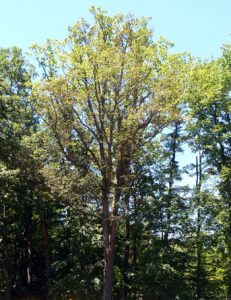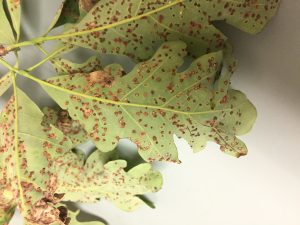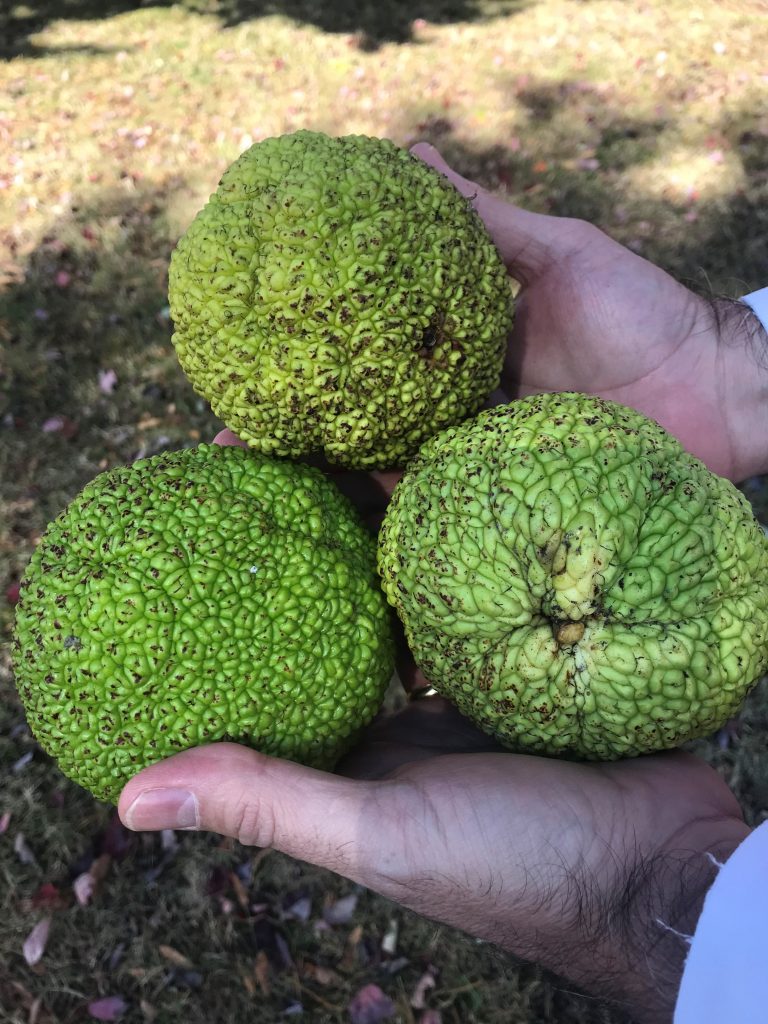QUESTION:
My Oak tree has a lot of brown leaves on it. Can you help me determine what is wrong?
DIAGNOSIS / RECOMMENDATION:
What you see in the picture at the bottom are damaged leaves from a non-sting wasp. We commonly see the effects of Jumping Oak Galls this time of year. The amount of leaves impacted on each tree can vary.
We do not have any insecticide treatment options, but the galls have little impact on the tree health. As seen in these photos, the tree suffered almost complete defoliation from infestation, but on the right we see the same tree just a week later full of new leaves. Your tree should be able to care for its own health given time.
To relieve pressure for future years, you can remove all fallen leaves by bagging them and removing them from your property. This will keep some larva from maturing and affecting the tree in future seasons. Also, if drought occurs later in the season water the tree to help relieve stress that may be impacting the tree health.


Photos 1 & 2: Left, A white oak that was nearly defoliated as a result of a severe infestation of jumping oak gall; Right, This is the same tree a week or so later showing new leaves growing. Photo credits: Dave Filipiak
ADDITIONAL INFORMATION:
The brown spots that you see on the leaves are a form of a blister from the tiny seed-like galls located on the underside of the leaves. Each gall serves as an incubator for a single non-sting wasp.

Photo 3
The name Jumping Oak Gall comes from when the larva hits the ground. After the larva hit the ground, you can see them jumping about an inch off of the ground, trying to position themselves on the soil surface to survive the winter.
RESOURCE LINKS:
All resource links accessed May 31, 2018
PHOTO CREDITS:
Photos 1 & 2: Michigan State University Diagnostic Services, used with permission
Photo 3: Alice Cox, 2018 Henrico County Extension Summer Intern
Do you have a gardening question that the Henrico Master Gardener Volunteers can help you with? The Henrico Extension Master Gardener Horticulture Helpline provides expert advice and guidance on a variety of gardening topics.
The Henrico Master Gardener Horticulture Helpline can be reached at (804) 501-5160, which also serves as the main number for the Extension office. The helpline will be staffed from 12:30 to 4:30 p.m. Mondays and Fridays and from 9 a.m. to noon Tuesdays, Wednesdays and Thursdays through October.
In addition, the public may call from 8 a.m. to 4:30 p.m. weekdays to leave a message. A Master Gardener will respond during the next shift.
For the helpline, a team of volunteer Master Gardeners will have access to a vast library of Extension publications and information on horticulture topics. Henrico’s Master Gardener program provides education and promotes research-based information on horticulture to the gardening public. For more information, go to henrico.us/extension.
Answers provided herein were based on specific situations and growing conditions.These recommendations may or may not be appropriate for all circumstances.For specific recommendations for your particular situation please contact your local Cooperative Extension Office.





